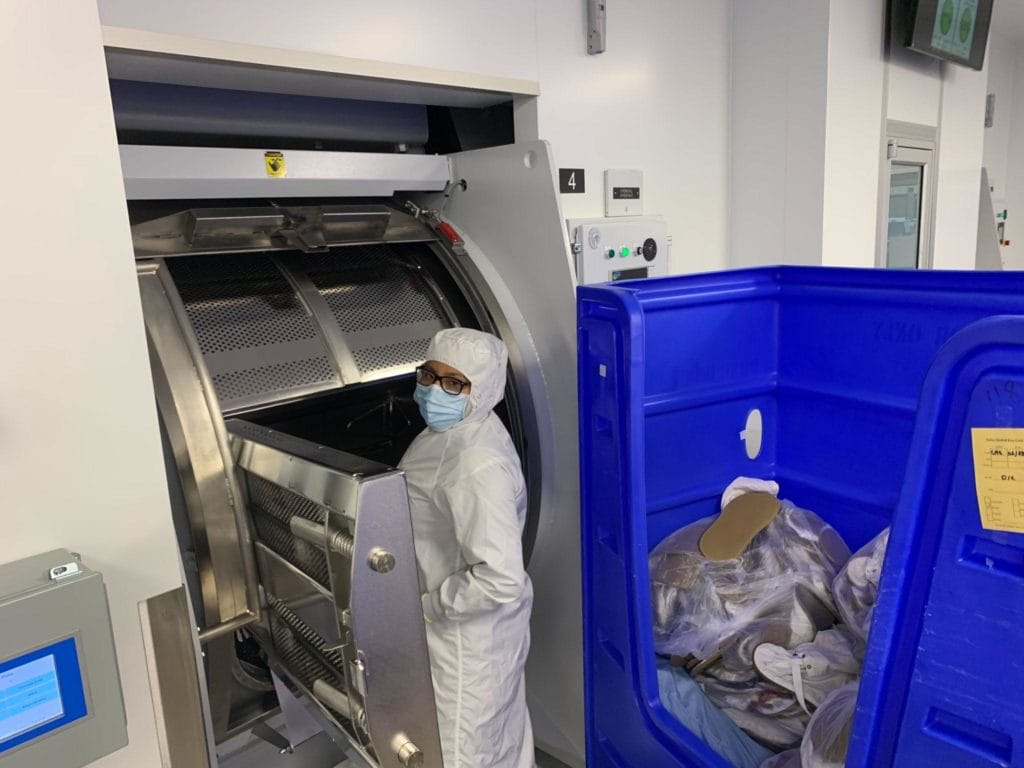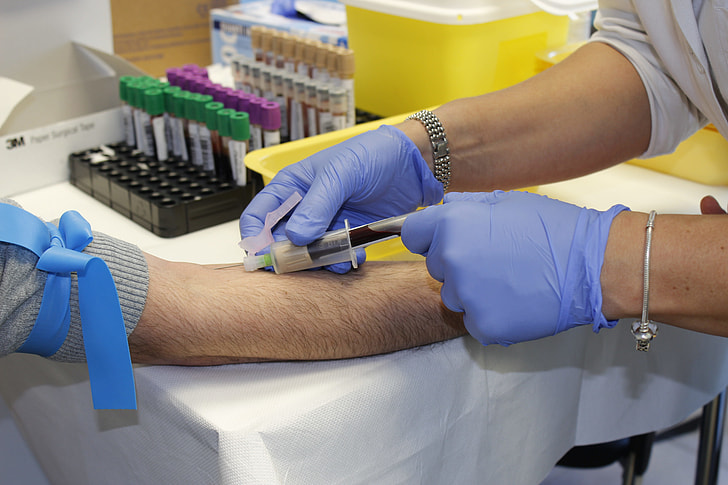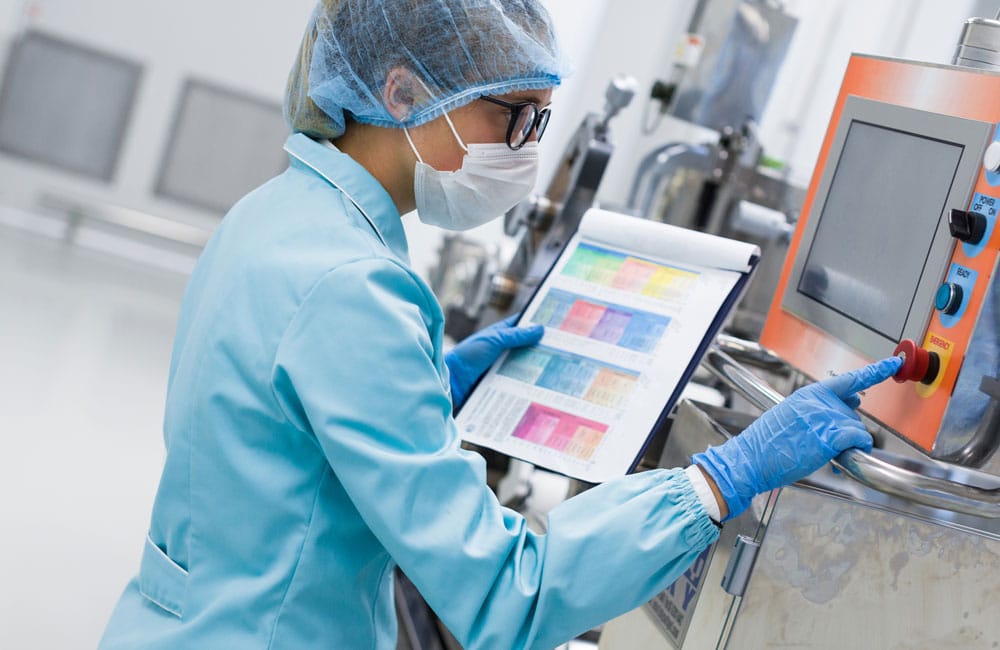
Food and pharmaceutical production environments demand the highest level of hygiene, contamination control, and personal protection. From the moment raw materials enter a facility to the final packaging stage, employees work in areas where microbial control is not a best practice—it’s a matter of legal compliance, product safety, and public health.
Unlike conventional PPE, which focuses primarily on mechanical and chemical protection, modern food and pharma sector PPE increasingly relies on antimicrobial fabrics—ultra-engineered textiles designed to resist bacterial growth, maintain hygiene, extend product lifespan, and actively prevent contamination.
This comprehensive guide provides a complete sourcing and decision-making framework, combining:
- Fundamentals of antimicrobial fabrics
- The science behind how antimicrobial textiles work
- Certifications and standards required in food and pharmaceutical facilities
- Material comparisons
- Misconceptions and real-world risks of non-compliant PPE
- Procurement checklists
- ROI-based arguments for management
- Case studies from food, beverage, biopharma, and nutraceutical plants
By the end, you’ll understand why antimicrobial fabrics are not just a technical upgrade—they are the hidden hero of modern PPE strategy.
Antimicrobial fabrics in food and pharmaceutical PPE inhibit bacterial growth, reduce contamination risk, improve hygiene compliance, and extend product durability.
They commonly incorporate silver ions, quaternary ammonium compounds, metal oxides, or advanced polymer coatings. PPE incorporating antimicrobial textiles is often tested under standards such as ISO 20743 (antibacterial activity), ISO 10993 (biocompatibility), HACCP, and FDA/EU food-safety requirements.
1. Why Antimicrobial Fabrics Matter in Food & Pharma PPE
Food and drug manufacturing environments operate under strict regulatory demands. Contamination risks stem from:
- High humidity
- Constant human interaction with materials
- Water-based cleaning environments
- Heat-intensive processing
- Airborne microbial risk
- Skin cells, sweat, and biofilms
Traditional PPE is passive—it acts as a barrier.
Antimicrobial PPE is active—it prevents microbes from surviving on the textile surface, keeping the PPE itself from becoming a contamination vector.
1.1 Human Presence Is the #1 Contamination Risk
Industry research shows:
- A single worker sheds 30,000–40,000 skin cells per hour
- 20–50% of food contamination events can be traced to fabric surfaces
- PPE fabrics can carry microbes for hours to days if untreated
In pharma environments, especially sterile filling lines and aseptic drug-fill operations, this is unacceptable.
Antimicrobial textiles reduce viable microorganisms on:
- Gowns
- Lab coats
- Gloves
- Face coverings
- Sleeves
- Aprons
- Shoe covers
1.2 Moisture Makes Things Worse
Food and drug processing frequently involve:
- Warm, humid environments
- Wet cleaning procedures
- Splashing
- Biofilm-friendly surfaces
Moisture provides bacteria with:
- Transport
- Nutrition
- Temperature stability
Microbes not only survive—they multiply.
Antimicrobial materials disrupt this cycle.
1.3 Increased Regulatory Pressure
Across the world:
- Food recalls are becoming more expensive
- Pharmaceutical production errors cause regulatory shutdowns
- Annual GMP audits are now stricter
- Traceability is mandatory in regulations like EU Annex 1, FDA GMP, and HACCP
Antimicrobial PPE helps facilities remove a major contamination uncertainty: fabric-based transfer.
2. The Science Behind Antimicrobial Fabrics
Antimicrobial PPE isn’t just “resistant to bacteria.”
It is engineered at the fiber, yarn, chemical, and polymer level to actively disrupt microbial survival routes.
2.1 What Makes Fabrics Antimicrobial?
Antimicrobial action can be:
Passive (physical)
Examples:
- Tight weaves preventing microbial penetration
- Hydrophobic surfaces preventing moisture attachment
Active (chemical or ionic)
Examples:
- Silver ions
- Quaternary ammonium compounds (QACs)
- Copper and zinc oxides
- Triclosan alternatives
- Chitosan
- Polymer-based microbe inhibitors
Photocatalytic
Some advanced fabrics use titanium dioxide or similar materials that activate under light and generate oxidative radicals that kill microbes.
2.2 How Do Antimicrobial Fabrics Kill or Control Bacteria?
Mechanisms include:
- Cell membrane disruption
- Interference with bacterial respiration
- Chelation of microbial DNA
- Ion exchange
- Cytoplasmic leakage
- Blocking cell wall synthesis
- Preventing biofilm formation
In short:
Antimicrobial PPE doesn’t just reduce contamination—it stops bacteria from multiplying in the first place.
2.3 Silver Ions: Still the Industry Gold Standard
Silver remains dominant because:
- It is effective against over 600 bacterial strains
- Microbes struggle to develop resistance
- It works in low concentrations
- It is heat-stable and long-lasting
This makes silver-ion fabrics ideal for:
- High-temperature laundering
- Cleanroom garments
- Multi-use PPE
- Lab coats and gowns
2.4 Advanced Next-Gen Antimicrobial Materials
Emerging technologies include:
- Graphene-based coatings
- Nano-ZnO
- Copper-silver hybrid matrices
- Plasma-treated polymer surfaces
- Cosmetic-grade skin-safe antimicrobials
- Halamine-based regenerable antimicrobial fabrics
These are increasingly seen in advanced pharmaceutical and biotech facilities.
3. Certifications & Standards for Antimicrobial PPE
Different regions have different requirements. Below are the key global standards typically required in procurement.
3.1 Testing Standards for Antimicrobial Effectiveness
| Standard | What It Covers |
|---|---|
| ISO 20743 | Quantitative antibacterial testing on textiles |
| AATCC 100 / 147 | US textile antimicrobial test methods |
| JIS L 1902 | Japan antimicrobial testing |
| ASTM E2149 | Dynamic contact testing |
3.2 PPE & Fabric Safety Standards
| Standard | Region | Purpose |
|---|---|---|
| ISO 13688 | Global | General garment performance |
| ISO 16604 | Global | Resistance to blood-borne pathogens |
| ISO 10993 | Global | Biocompatibility testing |
| EN 14126 | EU | Protective clothing for infectious environments |
3.3 Food & Pharma Production Compliance
| Regulation | Region | Application |
|---|---|---|
| HACCP | International | Hazard control in food production |
| FDA GMP / CFR Title 21 | US | Pharmaceutical & food manufacturing |
| EU GMP Annex 1 | EU | Sterile medicinal production |
| FSMA | US | Food safety modernization |
3.4 Color-Coding Requirements
Many facilities require:
- Blue: Raw handling
- White: Packaging
- Green: QC labs
- Red/Yellow: Chemical zones
Antimicrobial PPE must support industrial-grade color retention required for laundering up to 80–200 cycles.
4. Material Comparison: Antimicrobial Textiles in PPE
| Material | Key Benefits | Limitations | Best Use Cases |
|---|---|---|---|
| Polyester with silver ions | Durable, reusable, strong antimicrobial effect | Higher cost | Gowns, lab coats, cleanroom PPE |
| Polypropylene nonwoven (treated) | Low-cost, disposable | Lower mechanical strength | Disposable masks, shoe covers, sleeves |
| PU-coated antimicrobial fabrics | Resistant to fluids and chemicals | Less breathable | Aprons, wet zones |
| Chitosan-based textiles | Natural origin, skin-friendly | Lower heat resistance | Food handling areas |
| Copper composites | Strong antiviral performance | Can discolor | Pharma shift operations |
| Graphene-treated fabrics | Durable, non-leaching, conductive | Higher specialty cost | Biotech R&D and high-care areas |
5. Where Antimicrobial PPE Makes the Biggest Difference
5.1 Pharmaceutical Production
Major contamination risks come from:
- Skin particles
- Respiratory droplets
- Touch points
- Interruptions in asepsis during line changeovers
Antimicrobial PPE helps reduce facility bioburden dramatically.
5.2 Food Processing Facilities
Food contamination from PPE fabric surfaces is often overlooked because:
- Workers lean against equipment
- Sleeves and coat hems make frequent contact with conveyor sides
- Sweat and moisture accumulate inside garments
- Regular cloth PPE can become bacterial incubators
Antimicrobial PPE prevents this microbial accumulation.
5.3 Dairy & Beverage Plants
These facilities often combine:
- Wet floors
- Protein-rich soil contamination
- Warm temperatures
Microbes thrive here—especially yeast, mold, and lactic bacteria.
Antimicrobial PPE slows microbial growth between cleaning cycles.
5.4 Ready-to-Eat (RTE) Lines
These segments allow no room for contamination:
- Sandwiches
- Sushi
- Cooked meats
- Pharmaceuticals filled to sterile packaging
Antimicrobial fabrics support:
- Reduced recall risk
- Reduced colony counts on swabs
- Higher audit pass rates
6. Common Procurement Mistakes
6.1 Assuming All “Antimicrobial” Labels Are Legit
More than 50% of antimicrobial PPE globally is not properly certified.
Before purchase, always request:
- ISO 20743 or AATCC 100 reports
- Antimicrobial mechanism disclosure
- Wash durability data
- Migration & safety data (particularly in contact with food)
6.2 Choosing the Wrong Material for the Environment
Example:
- Silver-treated polyester works great in dry areas
- But in high-temperature wet zones, silver ions may leach faster
Wet dairy plants may require:
- PU-coated antimicrobial surfaces
- Nonwoven disposables in chemical wash zones
6.3 Underestimating Wash Durability
Many antimicrobial coatings fail after 20–40 wash cycles.
Professional-grade PPE should withstand:
- 80–200 industrial washes
- Constant steam sanitation
- 60–90°C laundering
6.4 No Worker Feedback System
A garment that is antimicrobial but:
- Heavy
- Hot
- Restrictive
…will not be worn properly.
Worker adoption is a hidden make-or-break factor.
6.5 No Colorfastness Verification
Facilities using HACCP zone color coding must ensure:
- Dyes do not fade
- Cross-contamination risk is minimized
- Visual identification remains instant
7. Case Studies
7.1 Nutraceutical Factory – USA
Problem
High swab counts from gown sleeves contacting equipment.
Solution
Introduced silver-based antimicrobial polyester gowns.
Result (12 months)
- 61% reduction in microbial colony counts
- No contamination alarms triggered
- Improved GMP audit compliance
7.2 Dairy Factory – Europe
Problem
Apron surfaces incubated lactic bacteria between cleaning cycles.
Solution
Shifted to PU-coated antimicrobial aprons with ISO 20743 compliance.
Result
- 35% faster cleanup time
- 40% reduction in PPE replacement cost
- Lower odor retention
7.3 Sterile Drug Fill Plant – Singapore
Problem
Disposable PPE waste exceeded 2 tons/month.
Solution
Switched to reusable antimicrobial cleanroom suits certified to EN 14126 & ISO 20743.
Result
- PPE waste reduced by 78%
- Suit lifespan increased 5×
- Payback period: 9 months
8. ROI Analysis
| Scenario | Cheap PPE Annual Cost | Losses from Contamination or Failure | Antimicrobial PPE Cost | Net ROI |
|---|---|---|---|---|
| Food facility contamination recall | $4,500 | $280,000 | $15,000 | +$269,500 |
| Pharma sterile line failure | $6,000 | $120,000 | $18,000 | +$108,000 |
| High PPE turnover & laundering | $12,000 | — | $5,800 | +$6,200 |
| Reduced swab retesting & audits | — | $36,000 | — | +$36,000 |
Even if antimicrobial garments cost 15–60% more upfront, their impact on:
- Recall avoidance
- Audit scores
- Bioburden
- Worker replacement schedules
- Laundering durability
…means they typically pay for themselves within a single quarter.
9. Buyer Checklist
9.1 Technical Requirements
- [ ] ISO 20743 / AATCC 100 antimicrobial verification
- [ ] Wash/laundry durability data
- [ ] Migration & skin-safety certification
- [ ] Clear antimicrobial mechanism disclosure
9.2 Facility Requirements
- [ ] Laboratory zones vs production floor zones
- [ ] Cleanroom grade
- [ ] Regulatory body (FDA, EU, HACCP, etc.)
- [ ] Disposable vs reusable preference
9.3 Procurement Best Practices
- [ ] Request 30-day trial samples
- [ ] Track microbiological swab data before/after
- [ ] Collect feedback from operators
- [ ] Verify fastest ROI area
10. Frequently Asked Questions (FAQ)
Q1: Do antimicrobial fabrics replace hand hygiene or cleaning?
No. They are additional controls, never replacements.
Q2: Are antimicrobial coatings safe for workers and food contact?
Yes, if properly certified under ISO 10993, FDA, and EU food safety guidelines.
Q3: How long do antimicrobial effects last?
Industrial PPE should retain effect for:
- 80–200 wash cycles (reusable)
- Entire usage time (disposable)
Q4: Do bacteria develop resistance?
For metal-ion-based systems such as silver and copper, resistance development is extremely rare.
Q5: Can antimicrobial fabrics reduce odors?
Yes—preventing bacterial growth reduces sweat and protein breakdown odors.
11. The Future of Antimicrobial PPE
11.1 Industry Shift Toward Smart Fabrics
Future PPE may incorporate:
- Embedded microbial sensors
- Self-sterilizing UV-active surfaces
- Graphene heat-conductive antimicrobial layers
- Machine-readable color coding
- RFID batch tracking
11.2 Sustainability Drivers
- Biodegradable antimicrobial treatments
- Waterless finish application
- Recyclable nonwoven structures
- Reusable cleanroom garments replacing disposables
11.3 Pharma Regulatory Alignment
With tightening EU Annex 1 rules and FDA sterility pathways, antimicrobial PPE will become not optional, but standard operating procedure.
12. Conclusion
Antimicrobial fabrics are no longer niche—they are a frontline defense in the global fight against microbial contamination in food and pharmaceutical production.
They provide:
- Higher hygiene levels
- Lower contamination transfer risk
- Better recall prevention
- Stronger audit compliance
- Dramatic improvement in PPE service life
- ROI measurable in months
Whether your facility processes:
- Aseptically filled vials
- Infant formula
- RTE chilled meals
- Biotech therapeutics
- Nutraceutical powders
…antimicrobial PPE helps protect:
- Workers
- Consumers
- Brands
- Regulatory standing
📩 For FDA-, EU-, ISO-, and HACCP-compliant antimicrobial PPE sourcing:
Email: [email protected]
🌐 www.workwearsolutions.net
Zion Zhang
Recent Posts
 From Silver Ions to Copper Threads: Comparing Antimicrobial Technologies2025年11月20日Modern food processing and pharmaceutical manufacturing […]
From Silver Ions to Copper Threads: Comparing Antimicrobial Technologies2025年11月20日Modern food processing and pharmaceutical manufacturing […] Case Study: How a Mining Firm Switched to 100% Recycled Fabrics2025年11月20日A major mining company successfully transitioned from […]
Case Study: How a Mining Firm Switched to 100% Recycled Fabrics2025年11月20日A major mining company successfully transitioned from […] Europe’s Circular Workwear Trend: What Emerging Markets Can Learn2025年11月19日The European workwear industry is increasingly embracing […]
Europe’s Circular Workwear Trend: What Emerging Markets Can Learn2025年11月19日The European workwear industry is increasingly embracing […] Why ESG Standards are Becoming a Must for Global PPE Projects2025年11月19日Global PPE projects are increasingly under scrutiny for […]
Why ESG Standards are Becoming a Must for Global PPE Projects2025年11月19日Global PPE projects are increasingly under scrutiny for […] Circular Workwear Programs: How Rental & Recycling Models Cut Waste2025年11月19日Circular workwear programs are transforming the traditional […]
Circular Workwear Programs: How Rental & Recycling Models Cut Waste2025年11月19日Circular workwear programs are transforming the traditional […] Recycled Polyester & rPET Workwear: Green Solutions for 20252025年11月19日The global transition toward circular manufacturing and […]
Recycled Polyester & rPET Workwear: Green Solutions for 20252025年11月19日The global transition toward circular manufacturing and […]
CONTACT US
- Feel free to contact us any time. We will get back to you as soon as we can!
- +86-17303331701
